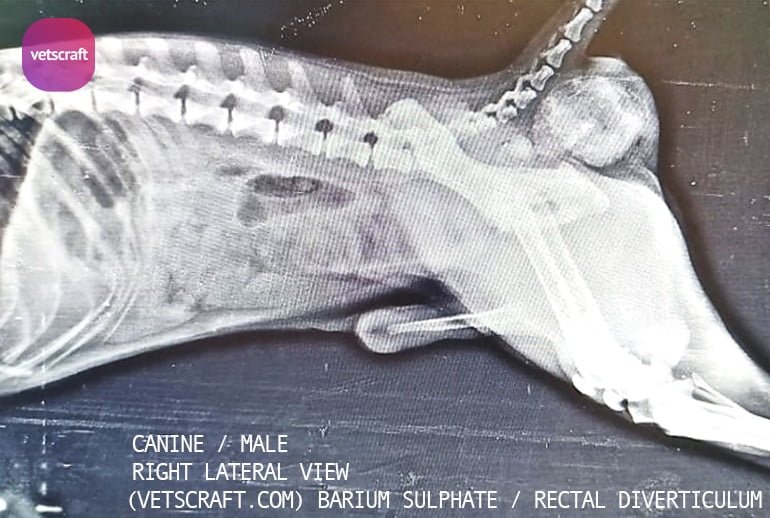TABLE OF CONTENTS
Contrast radiography in animals
Contrast radiography in animals is based on the radiodensity of the tissue itself or its surrounding tissues. The substance used for this purpose is called as Contrast medium. The substance used for this purpose are called as contrast medium.
Contrast medium
Contrast medium is a substance which is either radio opaque or radiolucent, that can be administered to the animal to increase radiographic contrast within an organ or a system.
An ideal positive contrast agent having the following properties–
- Contrast medium should have desired atomic number
- Contrast medium should be inert and its metabolic byproducts should not be toxic. Atomic number of uranium is 92 and of Lead is 82 but they are toxic
- Contrast medium should be retained in the area of interest only for a desired period
- Contrast medium agents used for outlining the excretory organs must specifically be excreted through that route in sufficient concentration so as to produce radiodensity of diagnostic value. For example- Barium sulphate for alimentary canal, Meglumine iodopamide for biliary system.
Contrast medium mainly classified as two types-
- Positive contrast agents
- Negative contrast agents
1. Positive contrast agents
Positive contrast agents are materials which increases the radiodensity of the structure or tissue in relation to surrounding tissue. Atomic number more than 50.
Examples of Positive contrast agents are Barium Sulphate, Water soluble iodine preparations, Cholecystopaque, Viscous and oily preparations etc.
Barium Sulphate
Barium Sulphate preparations are used mainly outlining alimentary tract . It is insoluble and is not absorbed in the body. If perforations are suspected in the tract they should not be used. Because it enters the peritoneal or pleural cavity and remains permanently in side and produce granulomatous reactions. They are available as powder, paste and suspensions.

Barium Sulphate are used for oesophagraphy, gastrography and reticulography. Barium meal is administered upto small intestine but where as Barium enema is used for rectum and colon.
Water soluble iodine preparations
Water soluble iodine preparations form the largest single group of contrast medium. They are opaque to X-rays, chemically inert, low in viscosity for rapid IV and low in toxicity, rapidly excreted in kidney and chemically stable so no iodine is released in the body.
Tri-iodinated compounds are widely accepted because they are well tolerated by the body and provide excellent contrast. They are supplied as sodium or meglumine salts of iothalamic diatrizoic or metrizoic acids or as a mixture of these two salts.
Examples of Water soluble iodine preparations are Meglumine iothalamate (called as conray 280), Sodium iothalamate (called as conray 420) and Iohexol (called as omnipaque 140, 180, 300, 350 etc.)
Water soluble iodine preparations are indicated in Angiography, Osteomedullography, Myelography, sialography, cystography, arthography etc.
Cholecystopaque
Cholecystopaque are water soluble organic Iodine preparations but exclusively excreted through biliary system and gall bladder. They are used for outlining biliary system and gall bladder.
Examples of Cholecystopaque are Iopanoic acid (Telepaque used in cholecystography), Sodium iopodate (Biliptin), Meglumine Iodipamide (Biligrafin forte I/v), Meglumine iodoxamate (Endobil), Meglumine iodipamide (Chrografin, Biligrafin) etc.
Viscous and oily preparations
The oily contrast materials consists of iodised oils. The oil contains a suspension of propyliodone in either water or arachidic oils. Because of viscous nature and insolubility in water they are not reabsorbed in the body and produce fat embolism. There uses are limited to lymphangiography or lymphography, dacrocystorhinography, and hysterosalphingography, sialography, myelography and bronchiography.
Examples of Viscous and oily preparations are Propyliodone (Dinosil aqueous 280 and dinosil oily 340), ) Iodised poppy seed oil (Lipidol (Ultrafluid 480)), Iophhendylate (Myodil-300) etc.
2. Negative contrast agents
Negative contrast agents are materials which relatively decrease the radiodensity of the tissue or structure.
They are gases that are more radiolucent to X-rays than that of soft tissues and have a black appearance on a radiograph.
Examples of Negative contrast agents are Air, 02, N2, N2O and CO2.
Air, O2, CO2 are commonly used. CO2 has a advantage over room air as it is better absorbed in to body in hallow organs where room air cause air emboli.